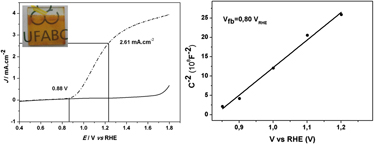Crossref Citations
This article has been cited by the following publications. This list is generated based on data provided by
Crossref.
Wang, Degao
Chen, Huaican
Chang, Guoliang
Lin, Xiao
Zhang, Yuying
Aldalbahi, Ali
Peng, Cheng
Wang, Jianqiang
and
Fan, Chunhai
2015.
Uniform Doping of Titanium in Hematite Nanorods for Efficient Photoelectrochemical Water Splitting.
ACS Applied Materials & Interfaces,
Vol. 7,
Issue. 25,
p.
14072.
Mariño-Otero, T.
Oliver-Tolentino, M.A.
Aguilar-Frutis, M.A.
Contreras-Martínez, G.
Pérez-Cappe, E.
and
Reguera, E.
2015.
Effect of thickness in hematite films produced by spray pyrolysis towards water photo-oxidation in neutral media.
International Journal of Hydrogen Energy,
Vol. 40,
Issue. 17,
p.
5831.
Liu, Kan
Wang, Hongyan
Wu, Quanping
Zhao, Jun
Sun, Zhe
and
Xue, Song
2015.
Nanocube-based hematite photoanode produced in the presence of Na 2 HPO 4 for efficient solar water splitting.
Journal of Power Sources,
Vol. 283,
Issue. ,
p.
381.
Huang, Qiang
Ye, Zi
and
Xiao, Xudong
2015.
Recent progress in photocathodes for hydrogen evolution.
Journal of Materials Chemistry A,
Vol. 3,
Issue. 31,
p.
15824.
Freitas, André L.M.
Carvalho, Waldemir M.
and
Souza, Flavio L.
2015.
Enhanced water oxidation efficiency of hematite thin films by oxygen-deficient atmosphere.
Journal of Materials Research,
Vol. 30,
Issue. 23,
p.
3595.
Souza, J. S.
Carvalho, W. M.
Souza, F. L.
Ponce-de-Leon, C.
Bavykin, D. V.
and
Alves, W. A.
2016.
Multihierarchical electrodes based on titanate nanotubes and zinc oxide nanorods for photoelectrochemical water splitting.
Journal of Materials Chemistry A,
Vol. 4,
Issue. 3,
p.
944.
Wang, Min
Wang, Hongyan
Wu, Quanping
Zhang, Chuangli
and
Xue, Song
2016.
Morphology regulation and surface modification of hematite nanorods by aging in phosphate solutions for efficient PEC water splitting.
International Journal of Hydrogen Energy,
Vol. 41,
Issue. 15,
p.
6211.
Carvalho-Jr, Waldemir M.
and
Souza, Flavio L.
2016.
Thermal enhancement of water affinity on the surface of undoped hematite photoelectrodes.
Solar Energy Materials and Solar Cells,
Vol. 144,
Issue. ,
p.
395.
do Amaral Carminati, Saulo
Souza, Flavio L.
and
Nogueira, Ana F.
2016.
Enhancing Hematite Photoanode Activity for Water Oxidation by Incorporation of Reduced Graphene Oxide.
ChemPhysChem,
Vol. 17,
Issue. 1,
p.
170.
Ampelli, Claudio
Genovese, Chiara
Centi, Gabriele
Passalacqua, Rosalba
and
Perathoner, Siglinda
2016.
Nanoscale Engineering in the Development of Photoelectrocatalytic Cells for Producing Solar Fuels.
Topics in Catalysis,
Vol. 59,
Issue. 8-9,
p.
757.
Perathoner, Siglinda
Centi, Gabriele
and
Su, Dangsheng
2016.
Turning Perspective in Photoelectrocatalytic Cells for Solar Fuels.
ChemSusChem,
Vol. 9,
Issue. 4,
p.
345.
Negreiros, Fabio R.
Pedroza, Luana S.
and
Dalpian, Gustavo M.
2016.
Effect of Charges on the Interaction of a Water Molecule with the Fe2O3(0001) Surface.
The Journal of Physical Chemistry C,
Vol. 120,
Issue. 22,
p.
11918.
Carvalho, Waldemir M.
and
Souza, Flavio L.
2016.
Hematite Surface Activation by Chemical Addition of Tin Oxide Layer.
ChemPhysChem,
Vol. 17,
Issue. 17,
p.
2710.
Freitas, Andre L M
and
Souza, Flavio L
2017.
Synergetic effect of Sn addition and oxygen-deficient atmosphere to fabricate active hematite photoelectrodes for light-induced water splitting.
Nanotechnology,
Vol. 28,
Issue. 45,
p.
454002.
Zhang, Qi
Wang, Hongyan
Dong, Yixin
Wu, Quanping
and
Xue, Song
2017.
Highly efficient hematite films via mid-/ex-situ Sn-doping for photoelectrochemical water oxidation.
International Journal of Hydrogen Energy,
Vol. 42,
Issue. 25,
p.
16012.
Phuan, Yi Wen
Chong, Meng Nan
Satokhee, Oodaye
De Souza, Andrew Brian
Zhu, Tao
and
Chan, Eng Seng
2017.
Synthesis and Characterization of a Novel Ternary Hematite Nanocomposites Structure with Fullerene and 2D-Electrochemical Reduced Graphene Oxide for Superior Photoelectrochemical Performance.
Particle & Particle Systems Characterization,
Vol. 34,
Issue. 1,
p.
1600216.
Ito, Nathalie Minko
Carvalho, Waldemir Moura
Muche, Dereck Nills Ferreira
Castro, Ricardo Hauch Ribeiro
Dalpian, Gustavo Martini
and
Souza, Flavio Leandro
2017.
High temperature activation of hematite nanorods for sunlight driven water oxidation reaction.
Physical Chemistry Chemical Physics,
Vol. 19,
Issue. 36,
p.
25025.
Jia, Lichao
Bogdanoff, Peter
Schmid, Martina
Bloeck, Ulrike
Fiechter, Sebastian
and
Wang, Hongqiang
2018.
Reconstruction of Solar Fuel Ultrathin Films via Periodically Microbending for Efficient Photoelectrochemical Water Splitting.
ACS Applied Energy Materials,
Vol. 1,
Issue. 12,
p.
6748.
Zhang, Qi
Wu, Quan-ping
Zhang, Yue
Yan, Ji-tong
Xue, Song
and
Wang, Hong-yan
2018.
A facile surface passivation of hematite photoanodes with molybdate overlayers for efficient PEC water oxidation.
Chinese Journal of Chemical Physics,
Vol. 31,
Issue. 6,
p.
833.
Zhang, Qi
Wang, Hongyan
Dong, Yixin
Yan, Jitong
Ke, Xuebin
Wu, Quanping
and
Xue, Song
2018.
In situ growth of ultrathin Co-MOF nanosheets on α-Fe2O3 hematite nanorods for efficient photoelectrochemical water oxidation.
Solar Energy,
Vol. 171,
Issue. ,
p.
388.



